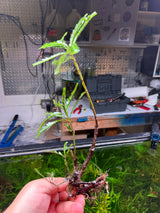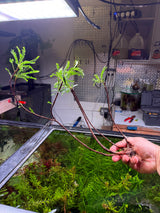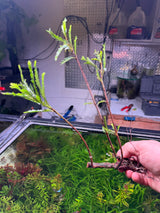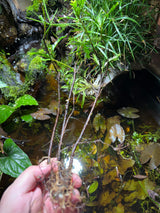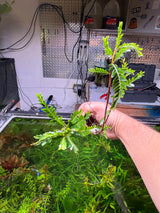Phyllanthus Balgooyi
$60
Description
Phyllanthus balgooyi is a remarkable and uncommon shrub or small tree in the family Phyllanthaceae that is native to the ultramafic (nickel-rich) soils of places such as the island of Palawan in the Philippines and Sabah, Malaysia.
Can grow with roots in water but not fully submersed
Key features include:
- Leaves arranged in a flattened (distichous) plane, with each branchlet bearing 20–70 small asymmetrical leaves.
- Typically seen as a shrub of 0.5 m up to about 2 m tall in cultivation or smaller habitats; in the wild in ideal sites it may grow taller.
- The bark is greyish-brown, and the fruit are small, 3-lobed capsules (greenish to brownish) produced in the leaf axils.
- One of the most fascinating traits: it is a nickel hyper-accumulator — the sap in its phloem can contain extraordinarily high levels of nickel (reports up to ~10–16% by weight in some organs) which gives the fluid a bright green hue.
In a horticultural setting, it’s valued for its unique foliage, compact form, and the “geeky” novelty of its metal-accumulating trait.
Care Instructions
Here’s a care guide tailored for growers/enthusiasts of Phyllanthus balgooyi — you may adapt or re-format this for your website as needed.
Light
- Provide bright, indirect to partial direct light. A location near a south- or east-facing window (if indoors) is ideal, but avoid harsh midday sun if your location is very hot. One source notes placing it less than ~3 ft (~1 m) from a window to ensure sufficient light.
- In its native habitat this plant grows in open ultramafic ridges and edges of rainforest, so it tolerates good light.
Temperature & Humidity
- Being tropical/subtropical, it prefers warm conditions — think 65–85 °F (18–30 °C).
- Avoid exposure to cold drafts or temperatures below roughly 50 °F (10 °C).
- Moderate to high humidity is beneficial (50%+). If your indoor air is very dry, consider a humidifier or placing it in a more humid room (bathroom with window, greenhouse shelf, etc).
Soil & Potting
- Use a well-draining, light substrate. A mix of cactus/palm soil with added perlite/pumice and perhaps a small amount of organic matter works well. Because this plant naturally thrives on soils derived from ultramafic rocks (which are often shallow, rocky, and well-drained) you want to avoid heavy, poorly-draining mixes.
- Choose a pot with drainage holes. Do not allow the plant to sit in water.
- Repot perhaps every 12–18 months (or when you see roots approaching the bottom or the plant has clearly outgrown the pot). Fresh substrate may help refresh nutrients.
Watering
- Allow the top portion of the substrate to dry slightly between waterings. Over-watering and soggy soil are among the most common pitfalls.
- In practice: water thoroughly until water drains from the pot, then wait. In typical indoor conditions you might water every 1–2 weeks (depending on pot size, light, humidity, and season). During more vigorous growth or high light/humidity you may need more frequent watering; in cooler, lower-light conditions reduce watering.
- Disable watering in very low-light or resting periods, but don’t allow the plant to completely desiccate for long.
Fertilising
- Provide a balanced, diluted liquid fertiliser (e.g., half-strength) during the active growth season (spring and summer).
- Given that the substrate will gradually lose nutrients, a light fertilising every 4–6 weeks during growing season is reasonable.
- In autumn/winter reduce feeding when growth slows.
- Ensure substrate freshness when you repot annually to replenish nutrients.
Growth & Maintenance
- Pinch back or prune lightly if you want to keep a compact shape. It naturally produces many branchlets and can become somewhat open or lanky if light is weak.
- Remove any dead or yellowing leaves to maintain appearance and reduce pest/humidity issues.
- Monitor for pests such as spider mites or mealybugs, especially in lower humidity / indoor conditions.
Propagation
- Can be propagated by seed or semi-hardwood cuttings in warm, humid conditions.
- Ensure good light and humidity during propagation to encourage root formation.















